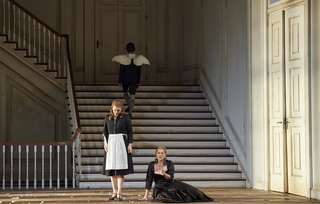|
Back
A long evening Toronto
The Four Seasons Centre for the Performing Arts
02/04/2016 - & February 7, 9, 13, 17, 19, 21, 22, 23, 25, 27, 2016
Wolfgang Amadeus Mozart: Le nozze di Figaro, K. 492
Josef Wagner*/Iain MacNeil (Figaro), Jane Archibald*/Karine Boucher (Susanna), Erin Wall*/Aviva Fortunata (Countess Almaviva), Russell Braun*/Gordon Bintner (Count Almaviva), Emily Fons*/Jacqueline Woodley (Cherubino), Helene Schneiderman (Marcellina), Sasha Djihanian (Barbarina), Robert Pomakov (Bartolo), Michael Colvin (Don Basilio), Doug MacNaughton (Antonio), Jean-Philippe Fortier-Lazure (Don Curzio), Uli Hirsch (Cherubim)
The Canadian Opera Company Chorus, Sandra Horst (chorus master), The Canadian Opera Company Orchestra, Johannes Debus*/Jordan de Souza (conductor)
Claus Guth (director), Christian Schmidt (set and costume designer), Olaf Winter (lighting designer), Andi A. Müller (video designer), Ramses Sigi (choreographer) 
J. Archibald, U. Kirsch, E. Wall (© Michael Cooper)
“I thought the Salzburg Festival was the gold standard!” exclaimed a perplexed friend after seeing this production imported from that august institution, where it was first performed in 2006 and again in 2011.
Its appearance marks the first time a work staged by Claus Guth has been seen in North America. It is underwritten in part by Sarah Billinghurst Solomon, former assistant general manager for artistic affairs at the Metropolitan Opera, and her husband Howard Solomon in memory of Gerard Mortier, who was a mentor to COC General Director Alexander Neef. Thus it’s a high-profile venture for an approach that can be termed more “high style” than truly reinterpretive - but will it lead to more Claus Guth productions on this continent? I’d be surprised.
The design of the work, both sets and costumes, is in black and white with occasional gray highlights. The hefty unit set looks like the unkempt stairwell of a musty old building. Not only is it devoid of furniture, but there seems to be no heating - why else would the Countess be wearing her fur-lined coat indoors? The costumes can best be described as ‘Hutterite chic”, except for the Act I chorus who are dressed in Salvation Army uniforms (yes, really!
A silent but busy character has been added to the cast: dubbed Cherubim, he is a body-double of Cherubino except with wings. Thus the mischievous Cupid who afflicted so many with surprising passions in 17th century opera is brought back to do what is already clear in Da Ponte’s libretto.
Two feathers fall from Cherubim’s wings and they are used talismanically throughout the work. There is also a dead raven that is variously brandished about leading us to think we have entered Edgar Allen Poe territory. The production has been described as “Bergmanesque”: well, perhaps, but it is Cries and Whispers that is conjured up, alas, not Smiles of a Summer Night.
At one point the Count must sing (”Hai gia vinta la causa”) while Cherubim rides on his shoulder. In another scene Cherubim rides a unicycle. Such a scene-stealer! (I usually enjoy scene-stealers, but not this time.)

R. Braun, U. Kirsch (© Michael Cooper)
When the cherub is not on stage we are treated to scenes where the volatile interrelationships are deftly portrayed (as one would expect and hope in any production). Director Guth seems to telling us he has the ability to direct a skillfully pointed drama but it is more important to belabour the disruptive nature of love and jealousy. A clever video is projected on to the back wall during the ensemble ending Act II; it graphically outlines the intertwining sub-plots - but this is something we are well aware of if we've been paying attention to the drama. Another example of directorial overkill.
Why is the Count going to such lengths to arrange an assignation with Susanna when they already roll joyously together on the floor?
For the final scene there is no garden, just the indoor set again, only now re-arranged à la M.C. Escher. (OK I get it, the world is going topsy-turvy.) The blocking for this intricate scene is what you might get at an early rehearsal when everyone realizes there is more work to do.
The production is well-cast, so Mozart’s astonishing parade of arias and ensembles delights the ear anew. The Count (Russell Braun) and Countess (Erin Wall) express many fraught emotions and some times (arguably too frequently) sacrifice vocal beauty to expressiveness. Josef Wagner, making his local debut, is terrific in every way as Figaro, even when he is made to “read” some of his recitatives from a booklet. Jane Archibald's sparkling voice impresses yet again. Also debuting is Emily Fons who embodies Cherubino to an astonishing degree. Sasha Djihanian delights with her little gem of an aria.
Johannes Debus adopts a steady, straightforward style somewhat slower than has become a recent trend under the influence of the “period” approach. The 49-member orchestra (with Jordan de Souza, pianist) vividly bring out Mozart’s witty, luscious detail. One can only wish there had been equal vividness and wit in the design and direction. One welcomes a fresh look at an established masterwork but this makes it seem stale. The result is a long evening that unfortunately feels that way.
The February 22 performance features singers from the Ensemble Studio, with Iain MacNeil as Figaro, Karine Boucher as Susanna, Aviva Fortunata as the Countess, Gordon Bintner as the Count, and Jacqueline Woodley as Cherubino. Jordan de Souza conducts on February 23 and 25.
Michael Johnson
|